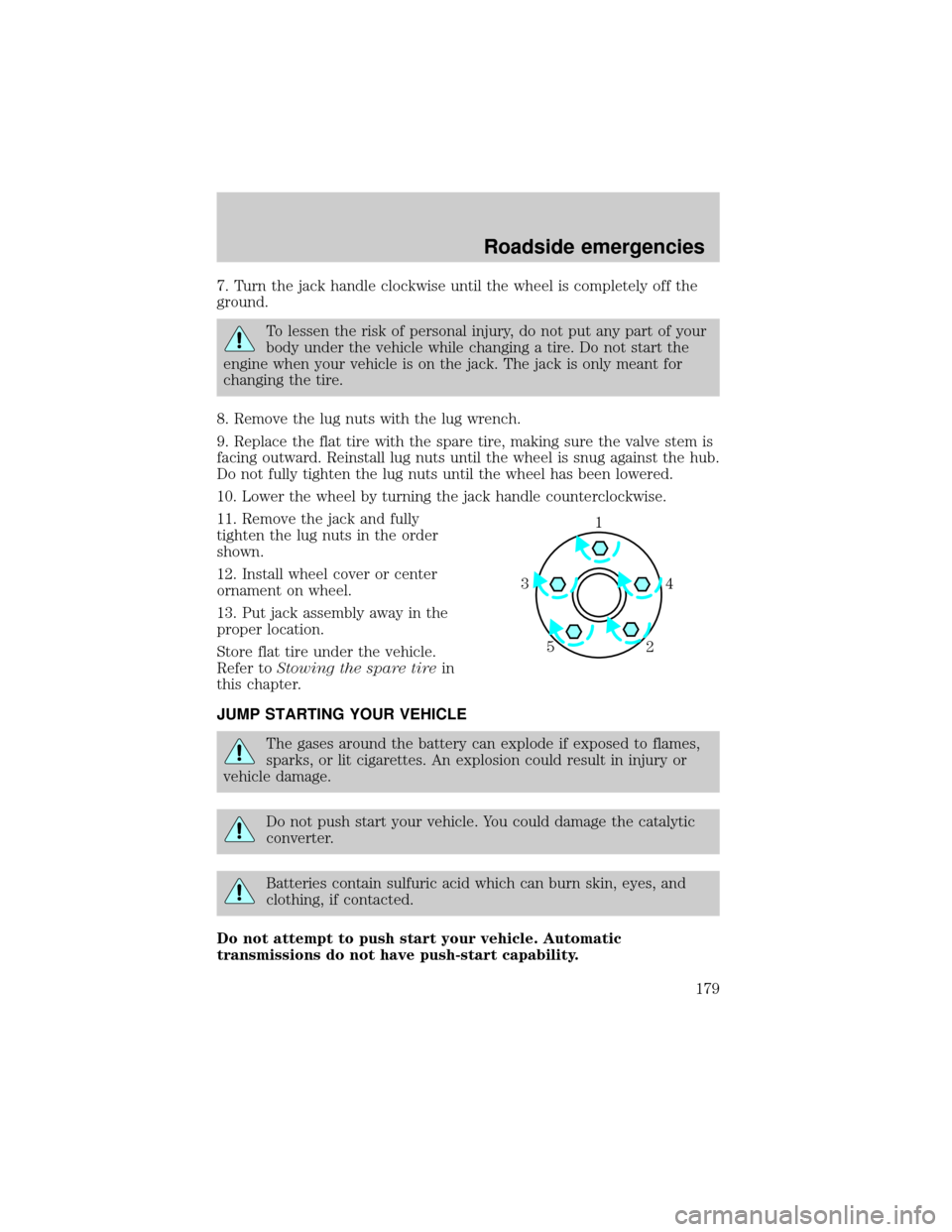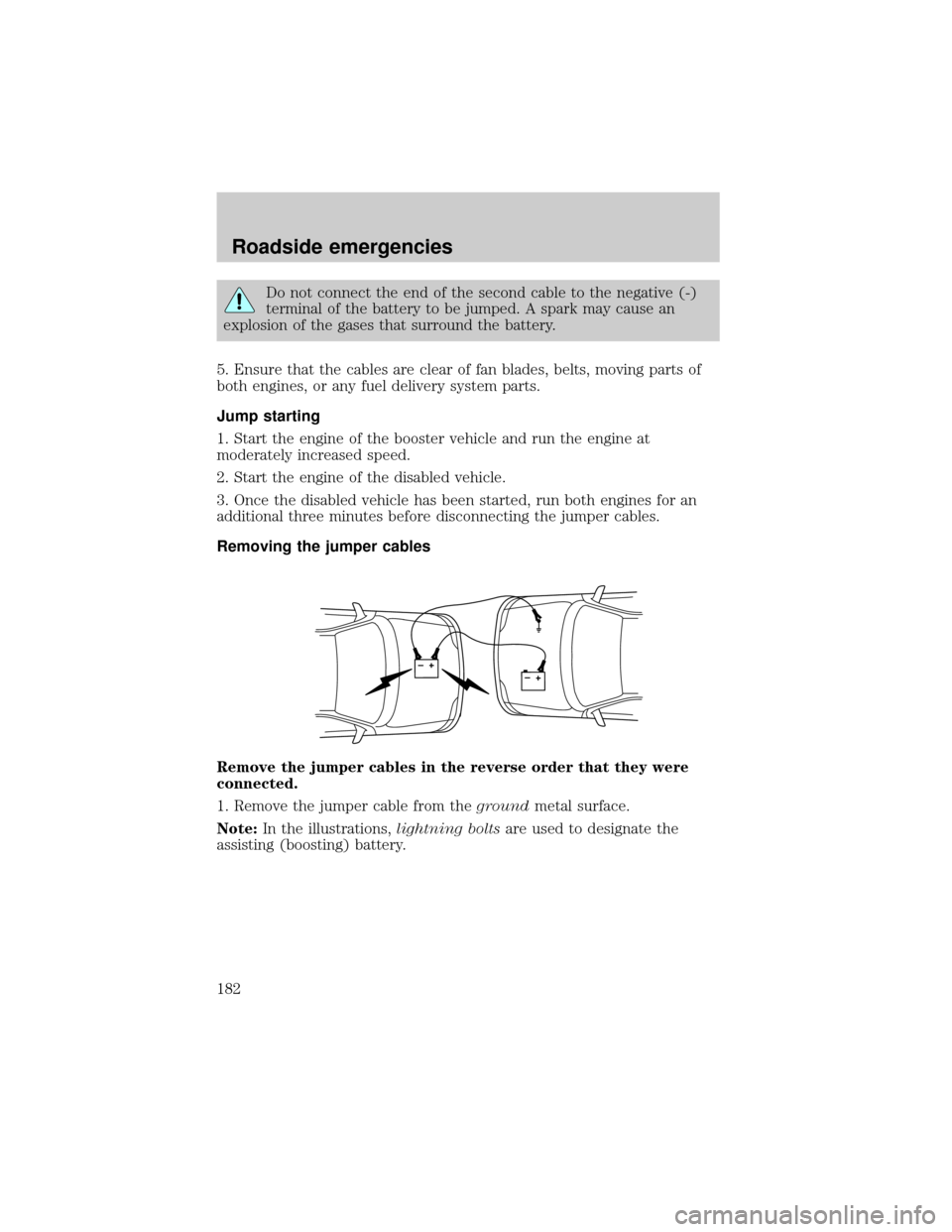jump start Mercury Villager 2001 Owner's Manuals
[x] Cancel search | Manufacturer: MERCURY, Model Year: 2001, Model line: Villager, Model: Mercury Villager 2001Pages: 256, PDF Size: 2.35 MB
Page 166 of 256

GETTING ROADSIDE ASSISTANCE
To fully assist you should you have a vehicle concern, Ford offers a
complimentary roadside assistance program. This program is separate
from the New Vehicle Limited Warranty. The service is available:
²24±hours, seven days a week
²for the Basic warranty period (Canada) or New Vehicle Limited
Warranty period (U.S.) of three years or 60 000 km (36 000 miles),
whichever comes first on Ford and Mercury vehicles, and four years or
80 000 km (50 000 miles) on Lincoln vehicles
Roadside assistance will cover:
²changing a flat tire
²jump-starts
²lock-out assistance
²fuel delivery
²towing of your disabled vehicle up to 56.3 kms (35 miles) from the
point of pickup (this can include to the nearest Ford dealership, or
your selling dealer if within the specified distance.) One tow per
disablement. Even non-warranty related tows, like accidents or getting
stuck in the mud or snow, are covered (some exclusions apply, such
as impound towing or repossession).
Using roadside assistance
Complete the roadside assistance identification card and place it in your
wallet for quick reference. In the United States, this card is found in the
Owner Guide portfolio in the glove compartment in Ford vehicles and is
mailed to you if you own a Mercury or Lincoln. In Canada, the card is
found in the Roadside Assistance book in the glove compartment.
To receive roadside assistance in the United States for Ford or Mercury
vehicles, call 1±800±241±3673 or if you own a Lincoln vehicle, call
1±800±521±4140. In Canada call 1±800±665±2006.
Should you need to arrange roadside assistance for yourself, Ford will
reimburse a reasonable amount. To obtain information about
reimbursement, call 1±800±241±3673 in the United States for Ford or
Mercury vehicles; or if you own a Lincoln vehicle, call 1±800±521±4140.
Call 1±800±665±2006 in Canada.
Roadside emergencies
166
Page 179 of 256

7. Turn the jack handle clockwise until the wheel is completely off the
ground.
To lessen the risk of personal injury, do not put any part of your
body under the vehicle while changing a tire. Do not start the
engine when your vehicle is on the jack. The jack is only meant for
changing the tire.
8. Remove the lug nuts with the lug wrench.
9. Replace the flat tire with the spare tire, making sure the valve stem is
facing outward. Reinstall lug nuts until the wheel is snug against the hub.
Do not fully tighten the lug nuts until the wheel has been lowered.
10. Lower the wheel by turning the jack handle counterclockwise.
11. Remove the jack and fully
tighten the lug nuts in the order
shown.
12. Install wheel cover or center
ornament on wheel.
13. Put jack assembly away in the
proper location.
Store flat tire under the vehicle.
Refer toStowing the spare tirein
this chapter.
JUMP STARTING YOUR VEHICLE
The gases around the battery can explode if exposed to flames,
sparks, or lit cigarettes. An explosion could result in injury or
vehicle damage.
Do not push start your vehicle. You could damage the catalytic
converter.
Batteries contain sulfuric acid which can burn skin, eyes, and
clothing, if contacted.
Do not attempt to push start your vehicle. Automatic
transmissions do not have push-start capability.
1
4 3
2 5
Roadside emergencies
179
Page 180 of 256

Preparing your vehicle
When the battery is disconnected or a new battery is installed, the
transmission must relearn its adaptive strategy. As a result of this, the
transmission may shift firmly. This operation is considered normal and
will not effect function or durability of the transmission. Over time, the
adaptive learning process will fully update transmission operation to its
optimum shift feel.
1.Use only a 12±volt supply to start your vehicle.
2. Do not disconnect the battery of the disabled vehicle as this could
damage the vehicle's electrical system.
3. Park the booster vehicle close to the hood of the disabled vehicle
making sure the two vehiclesdo nottouch. Set the parking brake on
both vehicles and stay clear of the engine cooling fan and other moving
parts.
4. Check all battery terminals and remove any excessive corrosion before
you attach the battery cables. Ensure that vent caps are tight and level.
5. Turn the heater fan on in both vehicles to protect any electrical
surges. Turn all other accessories off.
Connecting the jumper cables
1. Connect the positive (+) booster cable to the positive (+) terminal of
the discharged battery.
Note:In the illustrations,lightning boltsare used to designate the
assisting (boosting) battery.
+–+–
Roadside emergencies
180
Page 182 of 256

Do not connect the end of the second cable to the negative (-)
terminal of the battery to be jumped. A spark may cause an
explosion of the gases that surround the battery.
5. Ensure that the cables are clear of fan blades, belts, moving parts of
both engines, or any fuel delivery system parts.
Jump starting
1. Start the engine of the booster vehicle and run the engine at
moderately increased speed.
2. Start the engine of the disabled vehicle.
3. Once the disabled vehicle has been started, run both engines for an
additional three minutes before disconnecting the jumper cables.
Removing the jumper cables
Remove the jumper cables in the reverse order that they were
connected.
1. Remove the jumper cable from thegroundmetal surface.
Note:In the illustrations,lightning boltsare used to designate the
assisting (boosting) battery.
+–+–
Roadside emergencies
182
Page 184 of 256

After the disabled vehicle has been started and the jumper cables
removed, allow it to idle for several minutes so the engine computer can
relearnits idle conditions.
When the battery is disconnected or a new battery is installed, the
transmission must relearn its adaptive strategy. As a result of this, the
transmission may shift firmly. This operation is considered normal and
will not effect function or durability of the transmission. Over time, the
adaptive learning process will fully update transmission operation to its
optimum shift feel.
WRECKER TOWING
If you need to have your vehicle towed, contact a professional towing
service or, if you are a member, your roadside assistance center.
It is recommended that your vehicle be towed with a wheel lift or flatbed
equipment. Do not tow with a slingbelt. Ford Motor Company has not
approved a slingbelt towing procedure.
Roadside emergencies
184
Page 251 of 256

built-in child seat ...................231
engine compartment ..............228
exterior ....................................227
exterior lamps .........................228
instrument cluster lens ..........230
instrument panel ....................230
interior .............................230±231
mirrors .....................................228
plastic parts ............................228
safety belts ..............................231
washing ....................................226
waxing .....................................227
wheels ......................................227
windows ..................................230
wiper blades ............................229
woodtone trim ........................230
Climate control (see Air
conditioning or Heating) ............24
Clock ................................49, 61, 71
Console ......................................100
overhead ....................................98
Controls
power seat ...............................111
steering column ........................86
Coolant
checking and adding ..............193
refill capacities ................196, 232
specifications ..................233±234
Cruise control
(see Speed control) ....................82
Customer Assistance ................166
Ford accessories
for your vehicle ......................244
Ford Extended
Service Plan ............................237
Getting assistance outside
the U.S. and Canada ..............243
Getting roadside assistance ...166Getting the
service you need ....................237
Ordering additional
owner's literature ...................248
The Dispute
Settlement Board ...................240
Utilizing the Mediation/
Arbitration Program ...............243
D
Defrost
rear window ..............................42
Dipstick
automatic
transmission fluid ...................198
engine oil .................................189
Doors
door ajar warning .....................10
lubricant specifications ..........233
Driving under special
conditions
through water .........................159
E
Emergencies, roadside
jump-starting ..........................179
Emission control system ..........219
Engine ........................................234
check engine/service engine
soon light ..................................11
cleaning ...................................228
coolant .....................................193
idle speed control ...................201
lubrication
specifications ..................233±234
refill capacities ........................232
service points ..........................188
starting after a collision .........167
Index
251
Page 253 of 256

Heating ........................................24
heating and air
conditioning system .................24
HomeLink universal
transceiver (see
Garage door opener) ............94±97
Hood ..........................................187
I
Ignition .................................82, 234
Infant seats
(see Safety seats) .....................137
Inspection/maintenance
(I/M) testing ..............................220
Instrument panel
cleaning ...................................230
cluster ..................................8, 230
lighting up panel
and interior ...............................22
location of components ..............8
J
Jack ............................................175
positioning ...............................175
storage .....................................175
Jump-starting your vehicle ......179
K
Keys
key in ignition chime ...............13
positions of the ignition ...........82
L
Lamps
autolamp system .......................23bulb replacement
specifications chart ................225
cargo lamps ...............................22
fog lamps ...................................23
headlamps .................................22
headlamps, flash to pass ..........22
instrument panel, dimming .....22
interior lamps ...........................98
replacing bulbs ...............221±225
Lane change indicator
(see Turn signal) ........................87
Liftgate ......................................106
Lights, warning and indicator ......8
air bag ..........................................8
anti-lock brakes (ABS) ....11, 153
brake ............................................9
charging system ..........................8
cruise indicator ...................10, 86
door ajar ....................................10
high beam .................................10
low fuel ......................................11
low washer fluid .......................13
oil pressure .................................9
overdrive off ..............................13
safety belt ...................................9
service engine soon ..................11
turn signal indicator .................10
Load limits .................................160
GAWR ......................................160
GVWR ......................................160
trailer towing ..........................160
Locks
childproof ..................................92
doors ..........................................92
Lubricant specifications ...233±234
Lumbar support, seats .............113
Index
253
Page 255 of 256

jump starting ..........................179
Steering wheel
controls ......................................86
tilting .........................................90
T
Tachometer .................................14
Tires ...........................175, 208±209
changing ..........................175, 177
checking the pressure ............209
replacing ..................................210
rotating ....................................209
snow tires and chains ............211
tire grades ...............................209
treadwear ................................208
Towing .......................................162
trailer towing ..........................162
wrecker ....................................184
Transaxle
automatic operation ...............155
fluid, refill capacities ..............232
lubricant specifications ..........234
Transmission
fluid, checking and adding
(automatic) .............................198
lubricant specifications ..........233
Trip odometer .............................16
Turn signal ............................10, 87V
Vehicle dimensions ...................234
Vehicle Identification Number
(VIN) ..........................................236
Vehicle loading ..........................160
Ventilating your vehicle ...........151
W
Warning chimes ...........................13
Warning lights (see Lights) .........8
Washer fluid ..............................193
Water, Driving through .............159
Windows
power .........................................90
rear wiper/washer .....................88
Windshield washer
fluid and wipers ..........................88
checking and adding fluid .....193
checking and cleaning ....207±208
liftgate reservoir .....................193
operation ...................................88
replacing wiper blades ...........207
Wrecker towing .........................184
Index
255